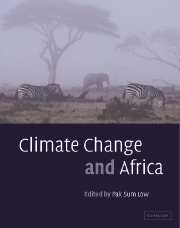Book contents
- Frontmatter
- Contents
- Notes on contributors
- Peer reviewers
- Editor's note
- Foreword
- Foreword
- Foreword
- Foreword
- Preface
- Preface
- Preface
- Preface
- List of abbreviations
- List of SI prefixes
- List of unit abbreviations
- List of chemical formulae
- Part I Science
- 1 Holocene climatic, hydrological and environmental oscillations in the tropics with special reference to Africa
- 2 The relative importance of the different forcings on the environment in Ethiopia during the Holocene
- 3 Global warming and African climate change: a reassessment
- 4 Interactions of desertification and climate in Africa
- 5 Africa's climate observed: perspectives on monitoring and management of floods, drought and desertification
- 6 Atmospheric chemistry in the tropics
- 7 Natural and human-induced biomass burning in Africa: an important source for volatile organic compounds in the troposphere
- 8 Biomass burning in Africa: role in atmospheric change and opportunities for emission mitigation
- 9 Soil micro-organisms as controllers of trace gas emissions over southern Africa
- Part II Sustainable energy development, mitigation and policy
- Part III Vulnerability and adaptation
- Part IV Capacity-building
- Part V Lessons from the Montreal Protocol
- Index
9 - Soil micro-organisms as controllers of trace gas emissions over southern Africa
Published online by Cambridge University Press: 10 December 2009
- Frontmatter
- Contents
- Notes on contributors
- Peer reviewers
- Editor's note
- Foreword
- Foreword
- Foreword
- Foreword
- Preface
- Preface
- Preface
- Preface
- List of abbreviations
- List of SI prefixes
- List of unit abbreviations
- List of chemical formulae
- Part I Science
- 1 Holocene climatic, hydrological and environmental oscillations in the tropics with special reference to Africa
- 2 The relative importance of the different forcings on the environment in Ethiopia during the Holocene
- 3 Global warming and African climate change: a reassessment
- 4 Interactions of desertification and climate in Africa
- 5 Africa's climate observed: perspectives on monitoring and management of floods, drought and desertification
- 6 Atmospheric chemistry in the tropics
- 7 Natural and human-induced biomass burning in Africa: an important source for volatile organic compounds in the troposphere
- 8 Biomass burning in Africa: role in atmospheric change and opportunities for emission mitigation
- 9 Soil micro-organisms as controllers of trace gas emissions over southern Africa
- Part II Sustainable energy development, mitigation and policy
- Part III Vulnerability and adaptation
- Part IV Capacity-building
- Part V Lessons from the Montreal Protocol
- Index
Summary
Keywords
Southern Africa; methane; nitric oxide; nitrous oxide; savannas; soil micro-organisms
Abstarct
Soils contribute to the budgets of many atmospheric trace gases by acting as sources or sinks. The most important trace gases include methane (CH4), nitrous oxide (N2O) and nitric oxide (NO), which are both consumed and produced by soils. In principle, one has to distinguish between the processes known to produce or consume these gases that are probably irrelevant at the low concentrations typical of atmospheric trace gases, and the processes that really play some role in the gas exchange between soil and atmosphere. The absolute values of total budgets and percentage contributions by soils should not be taken for granted, because the individual source and sink strengths are highly uncertain. There are a number of reasons for this uncertainty. The fluxes of trace gases between soil and atmosphere can be measured with some reliability by using various approaches, but it is not trivial to estimate atmospheric budgets from field fluxes. The problem is that fluxes generally show a high variability with respect to site and time. Integration of fluxes over larger areas and extended periods does not necessarily solve the problem, since each individual flux event is caused by deterministic processes that change in a non-linear way when conditions change even slightly. In addition, soils are presently looked upon as a macroscopic system, although the function is controlled predominantly on a microscopic level, i.e. the level of the micro-organisms.
- Type
- Chapter
- Information
- Climate Change and Africa , pp. 90 - 104Publisher: Cambridge University PressPrint publication year: 2005



